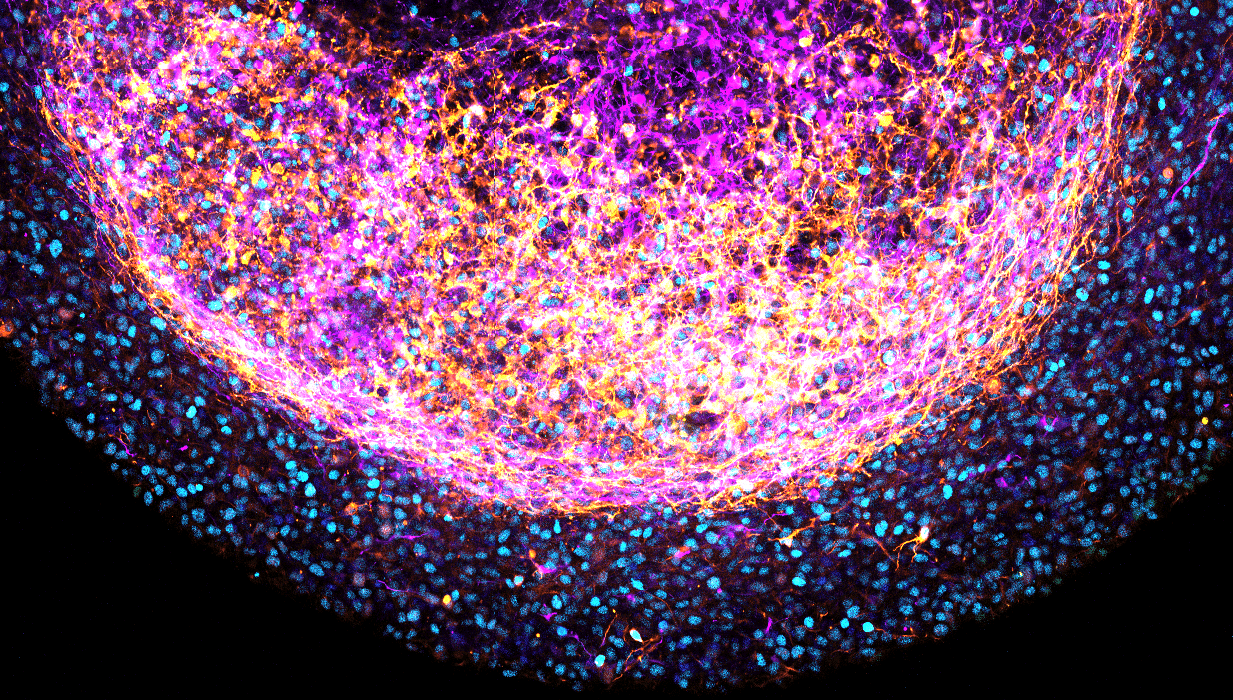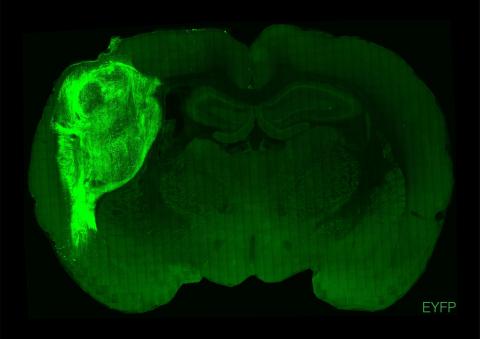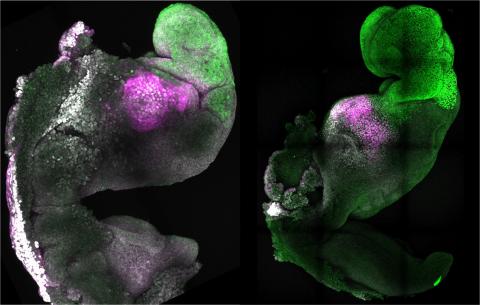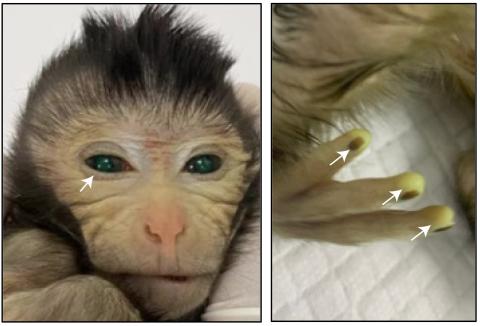Reactions to the development of brain organoids from human fetal brain tissue
A team led by the Princess Máxima Pediatric Oncology Center and the Hubrecht Institute (The Netherlands) has generated small 3D brain models--known as organoids--from human fetal brain tissue. Until now, these brain organoids-which attempt to resemble real organs on a miniature scale-were grown in the laboratory using pluripotent or embryonic stem cells. The new technique, published in the journal Cell, allows regions of brain tissue to self-organize into three-dimensional brain structures. The authors used these organoids and the CRISPR-Cas9 tool to simulate the development of one type of brain tumor, glioblastoma, and see how it responded to different drugs.

A zoom-in image of a part of a human fetal brain organoid. Stem cells are marked by SOX2 (cyan) and neuronal cells (TUJ1) are color coded from pink to yellow based on depth. Credit: Princess Máxima Center, Hubrecht Institute/B Artegiani, D Hendriks, H Clevers.
Lluís Montoliu - organoide cerebro fetal EN
Lluís Montoliu
Research professor at the National Biotechnology Centre (CNB-CSIC) and at the CIBERER-ISCIII
Organoids are multicellular groupings created in the laboratory from embryonic stem cells or stem cells present in tissues that can reproduce some of the cellular functions of the organ they represent. There are organoids of practically any organ (kidney, liver, pancreas, lung...) and also of the brain. The latter are the ones that, logically, raise the greatest ethical dilemmas: when could a brain organoid develop any capacity for thought or consciousness even remotely similar to that of a human brain?
These cellular structures have been very successful in recent years in biomedical research. In particular, because they have made it possible to replace many experiments that were performed using laboratory animals. Organoids are therefore the most obvious example of alternative methods to animal experimentation. Organoids can be derived from cells or tissues of both healthy and diseased people. Exposing organoids to a battery of experimental drugs to determine which has the greatest therapeutic significance avoids using many animals that would normally have been used for similar experiments.
However, organoids are not equivalent to the organs they model. Neither in complexity nor in diversity of cell types. Therefore, we should remain cautious when interpreting the results that we may derive from the use of organoids in research. In my opinion, the use of organoids is complementary (not entirely substitutive) to animal experiments, which are still indispensable. And that was directly manifested with the brain organoids. In 2022, Sergiu Pasca's laboratory injected neuronal cells derived from human brain organoids into the developing brains of newborn rats, causing them to diversify into several cell types, many more than those that would normally have appeared in vitro in organoids. This experiment succeeded in demonstrating the function of these neurons, which had obvious implications for the analysis of brain organoids derived from people with neurological diseases. It was a palpable demonstration of the argument that organoids complement, not replace, animal experimentation.
Now, a group of Dutch researchers has published in Cell the generation of new brain organoids obtained from fragments of human fetal brain tissue from hospital abortions, donated for research. The mixture of tissue fragments (and not, as until now, of single isolated cells) appears to generate brain organoids of higher quality and cellular complexity, capable of reproducing in culture many of the cell types present in a human brain. The new work comprehensively documents the utility of these new fetal human brain organoids in attempting to reproduce the architecture and function of an organ as complex as the brain in the laboratory.
I welcome these technical and practical developments in the generation of brain organoids. I am sure that they will allow progress in some aspects of the physiology of the central nervous system. It is to be hoped that the following experiments will make it possible to obtain similar organoids derived from fetal brains with some neurological disease, in order to evaluate their interest in the study of pathologies affecting the central nervous system, given that those now reported are derived from fetuses that are healthy in principle. However, let us not forget that most diseases, if not all of them, are caused by a malfunction of the body as a whole, with alterations in the interaction between different organs and tissues, with dysfunctions in our immune system. And all these aspects, for the moment, we cannot reproduce them in organoids. We still need the strictly regulated use of experimental animals, which complement the advances in organoids such as the one presented today to the scientific community.
Jacob Hanna - organoide cerebro fetal EN
Jacob Hanna
Professor of Stem Cell Biology & Embryology at Laboratory for Pluripotent Cell Studies and Ex Utero Embryogenesis at the Weizmann Institute of Science (Israel)
This is an interesting new study where they make brain organoids from fetal brain tissue.
It is well done as a proof of principle. It is important because it may offer clues on what happens in brain development during authentic brain formation (rather than lying on embryonic stem cell derived tissues).
There are a lot of theories out there that origins of childhood brain tumors might start during fetal stages and such technique may enable some insights and support of disprove such theories in the future.
Delilah Hendriks et al.
- Research article
- Peer reviewed
- Experimental study



